The Catholic Church in the United States
II. « The Church must accept America. »
(1865-1899)
ST. Elisabeth Seton warned Mgr Bruté de Rémur that he must not think that Americans « except perhaps one case out of a hundred » wondered whether there was a true Church and a false Church, a right faith and an erroneous faith. They belonged to one or another sect for mere « sociological » reasons, as we would say today, and thus were fed on unchallenged prejudice. That is why she advised the first bishop of Vincennes to prove the charity of the Church before establishing the truth of her Faith. Did this entirely evangelical pastoral theory also imply not only respect for but exaltation of American institutions a half-century later?
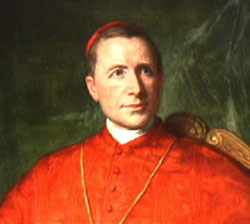
This question arises when we study the history of the Church in the United States between the Civil War and 1921. That was the year of Cardinal Gibbons’ death; he was the most outstanding prelate during this period. This epoch was characterised by a renewed attachment to the ideals of the new Republic, and thus to religious freedom. It seems that the Church was obeying a watchword: dispel prejudice against Catholicism by the practice of open-mindedness, constant dialogue, and respect for others in a common admiration of the new democratic order that originated in the United States. Today, let us take a look at this « charm offensive » that the Church launched; next month we will examine its results.
CHARITY OPENS HEARTS
Let us recall that in the first part of the 19th century, the Church had been unable, despite constitutional guarantees, to escape from two waves of persecution that were maintained by Protestant sects. She came out of the first wave, which lasted from 1834 to 1842, with increased stature. The revival of her expansion and the massive arrival of Irish Catholics provoked a second wave in 1852, which only died down in 1861 owing to the outbreak of the Civil War.
Nevertheless, this bloody civil war that plunged the young nation into mourning until 1865 did more than bring back religious peace, it changed the status of Catholics in the eyes of a good many Americans. The horrors of the war were in fact the occasion for many of them to discover Catholic charity, the equivalent of which was not to be found in any sect. In particular, the devotion of military chaplains and of the eight hundred women religious who were assigned to field ambulances eradicated much prejudice among both Northerners and Southerners.
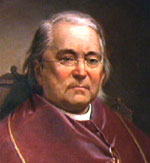
Furthermore, the Church appeared as an agent of unity and reconciliation in a country that civil war had divided and had left with wounds that would be long in healing. Before the war, while the bishops unambiguously reproved slavery, they declared themselves hostile to its immediate abrogation for the sake of public order. The sad events proved them right.
During the conflict, although they loyally served their respective governments of North and South, they never questioned the Church’s unity. As a result, when hostilities ended, the Episcopate, under the benign authority of Mgr Spalding, immediately formed one body that was ready to work for the good of the whole American society.
This was enough to cause a movement of general sympathy that was in singular contrast to the demonstrations of hostility of the previous years.
AN URBAN CHURCH COMPOSED OF IMMIGRANTS
The bishops, mainly of Irish origin, took advantage of this peaceful climate to develop Catholic works. Schools especially increased in number, churches were built, and parishes were founded. However, let us point out that the Catholic Church in the USA was urban, unlike the Church in Canada. In fact, with rare exceptions, the bishops, who lacked priests, preferred to gather immigrants in towns in order to be able to provide them with sacramental and educative services more easily and cheaply. In many dioceses, they were systematically discouraged from settling in rural areas. This « policy » would have serious consequences for both their birth rate, which would be markedly inferior to that of families living in rural areas, and the material prosperity of Catholics: they were confined to working-class labour and would need several generations to improve their standard of living.
Nevertheless, in the last third of the 19th century, the Church’s great challenge in the United States was to welcome the immigrants of nationalities other than Irish. Were they to be assimilated and thus anglicised? Or, on the contrary, should their national particularities be respected, especially their language, in order to help them conserve their Catholic traditions? This was the major debate that people were discussing in sacristies at that time.
Irish bishops opted for « Americanisation » as soon as possible, but their zeal provoked many oppositions and protests that were brought to Rome’s attention.
In reality, as we saw for the crisis in the 1840s, this cultural issue hid another that was much more serious, for it affected the purity of the Catholic Faith: liberalism. The need to guarantee the Church’s unity was a legitimate pastoral concern; all the more was this so because the national communities were sooner or later condemned to dissolve in the American melting pot. But would the Church thus have to become the passionate servant and advocate of American institutions and of the New World that they shaped? This is the crux of the matter… What kind of relationship must exist between the Church and democracy considered to be a progress of mankind to be spread throughout the whole world in order to achieve peace? Did the Church have to become the movement for the spiritual animation of American democracy?
In order to answer this question, it suffices to study the work of Cardinal Gibbons, Archbishop of Baltimore from 1877 to 1921! No other man had had greater influence on the course of Church history in the United States: he, as it were, personifies it.
THE CHURCH’S YOUNGEST BISHOP
He was born in 1834 in an Irish family that had arrived at Baltimore shortly before. Yet, his parents soon returned to Ireland, where he spent the whole of his youth. In 1853, his mother, who had been widowed, settled in New Orleans, the most Catholic city in the United States. It was there that he made a retreat preached by a young Redemptorist, Fr. Hecker, that determined his priestly vocation. He preferred, however, to enter Baltimore’s Sulpician seminary, where he was ordained a priest in 1861 after having made brilliant studies.
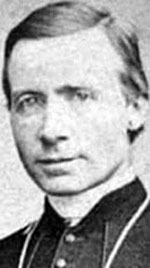
Vicar Apostolic
After seven years of priesthood, during which he distinguished himself by his courageous zeal and his intelligence, he was appointed vicar apostolic of North Carolina.
At thirty-two years of age, Mgr Gibbons was the youngest bishop in the world at that time, but his huge diocese numbered only eight hundred Catholics, who were scattered among a million Protestants. His life as a missionary had began. Frail-looking, sparkling with intelligence, gentleness, and courtesy, he easily won his listeners over. In the wave of sympathy in favour of the Church shortly after the Civil War, it was not rare for a Protestant pastor to lend him his temple in order to gather the few Catholic families of the area.
His first years as a priest and bishop unfolded in this climate of tolerance, which he considered as a progress far from the never-ending quarrels that cast a pall over old Europe.
He attended the First Vatican Council; however, given his youthfulness, he refrained from taking the floor. The American Episcopate was divided over the issue of pontifical infallibility: half of the bishops considered its definition inopportune, while the other half, led by the bishop of New York, Mgr McCloskey, defended it. Mgr Gibbons rallied to him from the first vote.

Archbishop of New York,
the first American Cardinal.
He kept a bad impression of this first trip to the continent of Europe. First, there was the declaration of war between Bismarck’s Germany and France. Above all, he noticed how much political fights reflected on the bishops’ debates in the Council. He then forged a conviction: old Europe was a finished world that was wasting away in fratricidal struggles, whereas the American system was the future.
On his return from the Council, while Pius IX made the bishop of New York the first American Cardinal, Mgr Gibbons was promoted to the Diocese of Richmond, which neighboured the see of Baltimore; all the while he retained his role administering his vicariate in North Carolina. He then became very active: a rigorous administrator, he founded new churches, often visited his priests, and preached without counting the cost.
« As always, his aim was to convert people, tells us Allen Sinclair Will, his first biographer, who, by the way, was a Protestant. He showed the same broad-mindedness that in North Carolina had gained him the affection of everyone, irrespective of beliefs. His sermons were aimed mainly at non-Catholics. He presented Christian truths simply, with such a broadness of outlook, and with such charity that criticism was disarmed. No one could be offended. Protestants thanked him for coming to their towns, and Catholics considered him as an honour of their faith. »
As Bishop of Richmond, he did not hesitate either to help the old Archbishop of Baltimore, Mgr Bayley. By this very fact, a true friendship united the two prelates and, in May 1877, he was finally transferred to Baltimore as coadjutor with right of succession. Six months had not passed when Mgr Bayley gave up his soul to God, and thus, Mgr Gibbons acceded to the most prestigious episcopal See of the United States.
THE UNITED STATES AND THE CHURCH WILL SAVE THE WORLD
From that time on, the new archbishop was persuaded that the Church had to attend to maintaining her unity. Thus he was in favour of Americanisation, meaning the rapid assimilation of immigrants to the American language and way of life as well as entire and wholehearted adherence to the “American spirit”. He was convinced that Americanisation was the most reliable bulwark of the Church in America. « For America to accept Catholicism, he liked to repeat, the Church must accept America. »
We will have to re-examine this affirmation, which, in order not to be false, would imply that the Protestantism from which the United States originates would have been able to accept Catholicism!
For the moment, let us retain, as Will explains it very well, that Mgr Gibbons « was determined to keep the Church of this country as homogenous as the nation. He was persuaded that nationalist groups in the Church would tend to become political elements. Factions would perturb her, whichever way she turned. In case of rivalry to obtain an episcopal see, the party defeated in the struggle would feel bitterness and would think about taking reprisals, perhaps by uniting with another foreign group. American bishops would be plagued with complaints and enjoined to take sides in favour of one group or another, and insoluble complications would follow. »
This stand also led him to insist on the beneficial role of the Church for the United States’ prosperity. Thus, we can read in a pastoral letter from 1884: « A Catholic feels at home in the United States, for the influence of the Church has always been exercised in favour of the individual rights and liberties of the people. A right-minded American can feel nowhere more at ease than in the Catholic Church, for he can breathe nowhere more freely the atmosphere of divine truth, which alone can make him free. »
Here is still another assertion: « The Catholic Episcopate of the United States is convinced that American political institutions can more easily assist a man to work his salvation than those of Europe and that they promise Catholicism a more perfect triumph than its medieval victories. »
THE THIRD COUNCIL OF BALTIMORE
It was in this spirit that he conceived of and presided over the works of the third Council of Baltimore in 1883. He was first opposed to the gathering of such an assembly for fear that its triumphalism might awaken anti-Catholic mistrust, but he resigned himself to it in view of the insistence of the bishops of the West. But then he wanted it to be the most comprehensive and effective possible, « so as not to need to gather a new plenary Council for many years to come. » As the apostolic Delegate appointed by Pope Leo XIII, he was in control of the assembly. This enabled him to arrange things so that his decrees showed such open-mindedness that they suited both non-Catholics and Catholics.
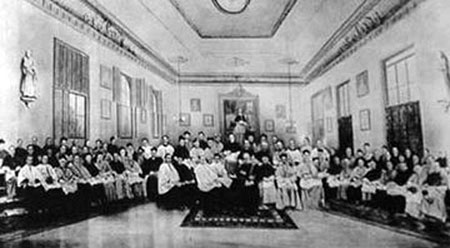
Leo XIII encouraged him to that end by telling him: « I detest all severe and harsh measures. I hate anathemas. I like to appeal to every man’s good sense, intelligence, and heart. As Vicar and servant of Christ, I wish to bring souls closer to our common Master. I have a duty to everyone. I have solicitude for all the Churches in Europe, Asia, Africa, and especially for the Church in your beloved country, the spiritual progress of which gave me ever so sweet a joy. »
Mgr Gibbons was anxious that the decisions of the Council should be in harmony with the civil institutions of the country. « He wished this intention to be so clear, his biographer tells us, that it exclude any criticism. He saw in this attitude a means to make thousands of people favourable to Catholic influence. »
By means of this, he masterfully conducted this plenary meeting of the American Episcopate. A remarkable common legislation resulted from this, in particular with regards to the training of priests and ecclesiastical discipline.
DEMOCRACY IS THE GOVERNMENT OF THE FUTURE
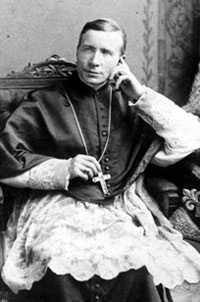
Archbishop of Baltimore
He was raised to the purple in 1887 and was held in high esteem by Leo XIII, with whom he shared the conviction that democracy was the government of the future, while monarchies belonged to the past. « It could not be the role of the Church, he said, to support any form of government and even less a form that is dying out. »
Nevertheless, he knew that democracy was fragile, and he feared nothing more than its ruin, which « would mark the ruin of civilisation. Now, the Church could contribute to saving it, first by adhering to the present system, which was sanctioned by the people, then by means of spirit of her belief, which is both lofty and conservative. »
The Archbishop of Baltimore, who had a passion for political matters carried out his duties as citizen with exactness to the point of always being the first to vote. « Officially, his biographer tells us, he did not belong to any party. He knew, however, the political tendencies of his country perhaps better than any other American. In the evening, in the peacefulness of his house, he liked to read the history of the United States and of its governments. It was his favourite study, after religion. He knew the federal Constitution and its jurisprudence perfectly. »
He was convinced that « Religion and Democracy were equally threatened by intolerance. » « He knew that clashes of opinion were inevitable in a Republic. However when these divergences concerned only politics, they vanished from the discussion; as soon as they touched on religion they became more serious. Thus it was necessary to fight intolerance, the common enemy of both religion and Democracy. »
When the Cardinal took possession of his titular church, S. Maria in Trastevere, he pronounced a discourse in which he opposed the situation of the Church in Europe, which was compelled to fight against constantly recurring despotism, and the United States’ system of freedom in the benevolent atmosphere of which « the Church opens out like a rose. »
One must reread this discourse with current world events in mind in order to grasp the naivety of the new prince of the Church:« I belong to a country in which the civil government extends its protection over us without intervening in the free exercise of our sublime mission as Christ’s ministers. Our country enjoys freedom without anarchy, authority without despotism. It puts up no barrier to prevent the foreigner from coming among us. It has no forts to drive the invader out. It is at peace with the whole world. It lives quietly, conscious of its strength and good will towards everyone. (…) If, however, we admit that we have a free government, we are perhaps not well enough aware that we have a strong government. Yes, our nation is strong. Under the conduct of almighty Providence, it draws its strength from the law’s majesty and supremacy, the loyalty of its citizens, and the attachment of its people to its free institutions. It is true that the attention of the citizens of the United States is focused on serious social problems at this time. Yet, I am certain that with God’s help, our people will resolve these problems with calm and good sense, without violence or revolution and respecting everyone’s rights. »
The main goal of this speech was, by his own admission, to show « that it is wiser to separate the Church from politics unless morality is at stake and that this method is the most advantageous for the Church in all countries. »
These words caused a scandal in Rome, but when the opponents heard that Leo XIII had written his approbation to the new American cardinal, they contented themselves with describing them with restraint as « particularly American ».
By the way, it was not the first time that Gibbons developed this theme. Thus, shortly after his return from a stay in Rome in 1883, he said to Baltimore’s authorities: « The more I go to Europe, stay there, and study the political organisation of its various countries, the more I admire that of my homeland, the prouder I am to be an American citizen. When I see standing armies of more than a million men in each European country; when I think how much they hinder economic expansion and how immoral they are; when I consider the danger of war that they represent for their neighbours; and when, on the other hand, I see our country and its fifty-five million inhabitants with fifty-five thousand soldiers who are scattered along our boarders, a country where we can go from Maine to California without meeting any soldier or policeman; when I know that if necessary each one of my compatriots is ready to defend his homeland and die for it without having been cooped up in barracks; when I think about our material prosperity; and above all, when I see authority uniting so well with civil and religious freedom; despite our political corruption, I thank God for all the favours that He has given us and I pray to Him that He continue to extend His protection over us like a mantle. »
Obviously, he could no longer say this today! But, by devoting such admiration to American institutions, did Mgr Gibbons not give a political power that was emancipated from Jesus Christ’s sovereignty free reign to conquer the world?
BOLD INITIATIVES
His “American spirit” would also lead the Archbishop of Baltimore to take bold initiatives. Since the beginning of his episcopate, he was inclined out of temperament and pastoral practice to what we today call “dialogue” with Protestants. Breaking with the reserved attitude of his predecessors, he honoured with his presence all the social or political manifestations of Baltimore, whatever the religion of their organisers might be. It was also known that he maintained lines of friendship with a great many politicians and with every President of the United States, whom he regularly visited in Washington.
Nevertheless, he was not ecumenist in the present-day sense of the term. He categorically refused to support a movement of this kind, which was of Anglican origin. He considered that « religious discussions are not an evil in themselves. On the contrary, they give proof of both sound intellectual activity and an obvious zeal for the cause of the truth. Yet, in order for them to be useful and edifying, the only motive for the parties engaged must be love of the Truth. They must set out their opinion with calm and moderation; they must consider the question in itself, without side issues; each party must treat his adversary with courtesy and benevolence without ever resorting to vile words and bad reasons; discussion must be stopped as soon as it offends charity. »
« Not only, Will writes, did he render Protestants more tolerant towards Catholics, and reciprocally, but he also rendered the various Protestant denominations more tolerant towards each other. He accomplished this without making the slightest concession on essential subjects or any compromise in his convictions. Quite to the opposite, he explained to them the teaching of the Church in The Faith of our Fathers with the plainest language. To his amazement, this book became the greatest bestseller for a Catholic book written in English. It became the book to which every reader who was anxious to inform himself about Catholic doctrine and practices referred. (…) He would later say frankly: “What pleased me the most about this book is that it explains the Catholic religion without containing a word that could wound our Protestant brethren. There was first a reference that seemed to displease the Episcopalians but when I was informed about it, I quickly ordered that it be removed.” »
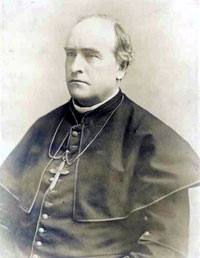
Bishop of Rochester
In the same spirit and despite the opposition of some Archbishops, he allowed Catholics to participate in the « World Parliament of Religions », which was organised as part of the World Fair of Chicago in 1893. « The more the Church is known, the more she is loved », he liked to repeat. Although he was seriously ill, he did not renounce participating in it and gave a speech that was already marked by the spirit of the Second Vatican Council: « I consider that by possessing the faith, I possess a treasure the value of which makes all the treasures of the world worth nothing. Instead of keeping these treasures in my safe, I would most willingly share them with everyone. In giving others riches, I would not grow poorer. In matters of faith, we do not have the same ideas, but we have things in common: charity, humaneness, goodness… We know that the good Samaritan rescued his brother who did not have either the same name, the same religion, or the same nationality as he. This is the example that we must all follow. »
Such initiatives would cause a stir in the episcopate; in particular the bishop of Rochester, Mgr McQuaid, reacted. German priests, who were already opposed to the Irish episcopate on the matter of schools, as we will see, did not hesitate to denounce them to Rome, but in vain. Gibbons had the unconditional support of Leo XIII, whom he kept informed about everything.
In order to calm people, Mgr Gibbons also admirably took advantage of the deliberately provocative attitude of Mgr Ireland, the very liberal Archbishop of Saint Paul.
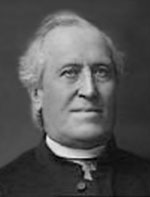
A deep esteem united the two prelates, who were animated by a great many common convictions. The Archbishop of Saint Paul was said to love his country « as much as Washington did ». In his eyes, America had to be the light of the world, but to this end it needed religion. The Church’s duty was thus to practice the principles of public freedom, equality, and disinterestedness, and to teach them to mankind. In order to implement this Movement for the Spiritual Animation of Universal Democracy before the Abbé de Nantes had invented the expression, Mgr Ireland did not burden himself with diplomatic precautions. « He braved incomprehension like the martyrs in order to be able to reduce and destroy it ». In comparison, Mgr Gibbons, despite the fact that he professed almost the same ideal, appeared to be a man of order to whom most of the moderate conservative bishops always ended up rallying.
SUPPORT FOR TRADE UNIONS
It was also the concern to integrate the Church into American society that led Mgr Gibbons to be the first American prelate to take interest in the social matter. In an initial stage, American capitalism was able to develop without resorting to an exploitation of the proletariat comparable to what existed particularly in England. But the massive arrival of immigrants made the conditions of working-class life markedly more precarious, while colossal fortunes were being made.
Several labour organisations had formed more or less spontaneously. One of them, the « Knights of Labour », met with prodigious success; by gathering a half million workers, it thus became the forerunner of American trade unionism. Now in agreement with the Holy See, the Canadian episcopate condemned it as a secret society opposed to religion. Then the Master Worker of the Knights, who was himself a practising Catholic, came and spoke in his own defence with the influential Archbishop of Baltimore. He assured him that he was not a Freemason, that the Knights were not a secret society and that they did not support principles opposed to the Church’s teaching.
Gibbons carried out an investigation, conversed at length about the question with his friend, President Cleveland, and concluded about this that it was of prime importance to obtain the lifting of this condemnation. He dreaded to think that « the Church could appear as the friend of powerful wealth and the enemy of defenceless poverty. »
He impressed on Rome’s prelates that this condemnation was neither justified, necessary, nor prudent; on the contrary, it was dangerous for the Church’s reputation in a democratic country. Moreover, it would doubtless be ineffective, since the workers in the United States, the majority of whom were not Catholic, would not obey Rome’s injunction. Supported by the English Cardinal Manning, he obtained for the first time in the annals of the powerful Holy Office that it reconsider its judgement and lift the condemnation, including French Canada, where workers were, however, Catholics.
Mgr Gibbons had the same determining influence when the encyclical Rerum Novarum was written. Along with Cardinal Manning, he would have persuaded Leo XIII to recognise the legitimacy of trade syndicalism rather than to recommend only institutions where workers and employers work together within trades. In point of fact, Gibbons did not want to go against the social practice in the United States where trade organisations were unknown…, and he did not envisage for a second that the Church could teach something to America!
At the dawn of the 20th century, the Archbishop of Baltimore wanted to consider only one aspect of reality: « the Catholic Church opens out like a rose » in the shade of the starry banner. The little Catholic flock that in 1790 numbered only 25,000 Catholics, one bishop, and twenty-three priests a century later became a powerful institution that gathered 9 million faithful, 13 Archbishops, 71 bishops, 8000 priests, 10,500 churches, 27 seminaries, 650 Catholic secondary schools and universities, 3000 parish schools, and 520 hospitals or asylums. For his part, Mgr Gibbons, a Cardinal of the Holy Catholic Church, enjoyed an unequalled prestige among his compatriots.
Nevertheless, Mgr Gibbons had no reason to crow. Three major affairs should have shaken his infatuation for the “American spirit”: the school question, the expansion of American imperialism, and the heresy of Americanism. We will study them next month in order to see how under the system of religious freedom and seemingly « in security beneath the American flag », the Church only grew thanks to immigration while her morality became laxer. On the other hand, Freemasonry’s power was quite free to conquer the world.